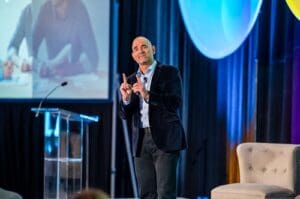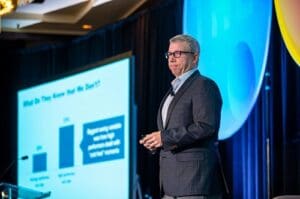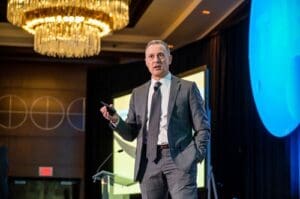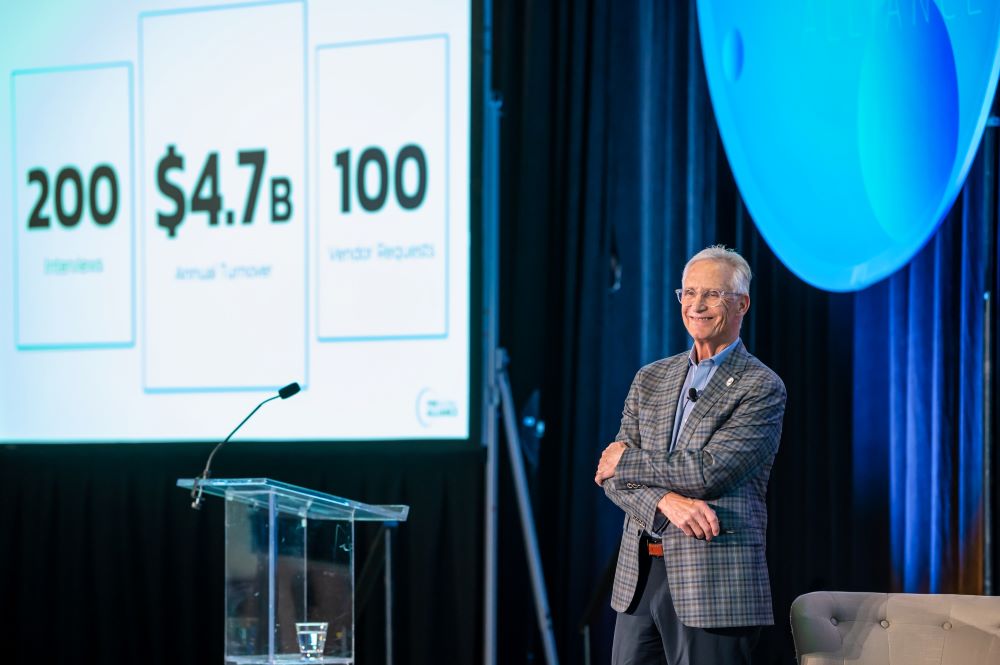We all know that commercial AV industry members love learning about emerging technologies and how we can deploy them to deliver exceptional experiences. Equally important, however, is our industry community’s passion for continual self-improvement and business enhancement. It’s why a business-optimization-minded publication like Commercial Integrator enjoys success, and it’s why 180-plus of commercial AV’s brightest minds flocked to the 16th annual PSNI Supersummit, organized by the PSNI Global Alliance, earlier this month. With the tagline “Resolve to Evolve,” PSNI Supersummit centered on strategizing to bring about meaningful industry improvement.
The Alliance is composed of best-of-breed Certified Solution Providers (CSPs) whose specialties extend from audiovisual integration to unified communications and collaboration (UC&C), as well as Preferred Vendor Partners (PVPs) whose operations span manufacturing, distribution, services and beyond. At PSNI Supersummit, Alliance stakeholders come together to learn, network, plan and pivot, empowering members to optimize their operations and deliver better outcomes globally.
Once again, Commercial Integrator had the honor of attending. What follows captures just a taste of the experience your industry peers had in Dallas this spring.
PSNI Supersummit: An Inside Look
Before delving into the packed PSNI Supersummit agenda, it’s worth exploring some of the differentiators that set the Alliance apart. During the event, Christopher Miller, executive director, took to the stage to emphasize not only the Alliance’s power but also its global reach. Indeed, there are 108 CSPs, with 254 offices, spread across 61 countries. Combined, they boast a staggering $4.7 billion in annual turnover. The Alliance has offices in 96% of the top 50 GDP cities in the world; that means members both leverage global expertise and seize global opportunities. All the while, Miller and his team have succeeded in keeping the organization tight knit, with a very low acceptance rate and strict requirements with regard to both skills/capabilities and alignment with a strategic geographical model. These facts undergird the Alliance’s “Built for You” mantra, which nods not only to its exclusivity but also to its commitment to helping drive CSPs’ success and client enablement.
And driving success is much of what PSNI Supersummit is ultimately about. Over three days, it puts business leaders in the same room and facilitates meaningful connections. During every lunch, dinner, coffee break and networking session, the Hyatt Regency Dallas thrummed with energy, members’ eyes alight with new ideas and fresh inspiration. Our industry grounds itself in relationships, and it was easy to see how the event rejuvenated members who, over the past three-plus years, haven’t always had a chance to commune in person. But the interpersonal engagement was only one piece of the puzzle; PSNI Supersummit also featured revelatory thought leadership that undoubtedly sent Alliance members home with actionable takeaways. We’ll turn to that next.
Global Perspective
In filling out its PSNI Supersummit speaker roster, Miller and his team at the Alliance bring together disciplines like economics, futurism, sales-team optimization and workforce management. What follows are synopses of each speaker’s presentation.
Afshin Molavi, a senior fellow at the Foreign Policy Institute of the Johns Hopkins University School of Advanced International Studies, delivered a geopolitical and economic outlook that one could just as accurately describe as a paean to the benefits of globalism. He mentioned, for example, that the U.S. boasts $2.5 trillion in annual exports, which collectively support nine million American jobs. When one couples foreign direct investment in the U.S. with exports, one arrives at about 20 million U.S. jobs that depend upon robust global engagement. Molavi also underscored the near-limitless upside available to us if we, as a country, lean into global opportunity. Collectively, Asia, Africa and Latin America make up 85% of the world’s population, he said, and many of those regions have a far younger population than we do. (Indeed, in sub-Saharan Africa, the median age is just 19.) For the Alliance, which is decidedly worldwide in scope, the potential is vast.
With regard to the economic outlook, Molavi painted a nuanced picture — neither as bad as we feared nor as rosy as we’d like. He harked back to last September, when he said economic analysts were in a “revised downward” mood, a colloquial way of saying that many were cutting their growth forecasts. But, Molavi added, by this past January, International Monetary Fund (IMF) forecasts, while not stellar, looked markedly better. “The good news is, commodity prices are easing,” he said, noting a similar trend in shipping rates and heralding the beginning of supply-chain normalization. Potential headwinds center on China, whose slowing growth has broader implications. “As goes China, so goes the world,” Molavi said, pointing to extensive economic integration between the country and the United States. And he forewarned that a possible new cold war with the Xi Jinping-led nation would present considerable economic risk.
‘The Last 8%’

According to Dr. Pawliw-Fry (pictured above), high-performing cultures meld two elements: high connection and high courage.
Dr. J.P. Pawliw-Fry, an expert in emotional intelligence, leadership and peak performance, delivered a keynote focusing on how attendees’ organizations can move beyond being just good and reach the “last 8%” to achieve greatness. Emphasizing team culture as the critical factor to unlocking exceptionally high performance, he underscored that leaders’ actions when they face difficult moments represent arguably the most pivotal time for shaping team culture. According to Dr. Pawliw-Fry, high-performing cultures meld two elements: high connection and high courage. “Connection,” of course, refers to unity of purpose within teams and mutual investment among team members. “Courage” refers to embracing accountability and being willing to make tough decisions that, ultimately, will facilitate teamwide success.
Lots of businesses describe themselves as being “family-like,” but, according to Dr. Pawliw-Fry, that can sometimes come at the expense of having a courageous team culture that embraces constructive criticism and the imperative to correct. It’s all too easy for us to fall into our “predictable default behavior” — in short, what we do when we face a tough situation. For most of us, we either (a) avoid it or (b) make a mess. When a team’s dynamic is too family-like, leaders can simply turn a blind eye to problem areas (i.e., “avoid it”), ignoring underperforming players or disruptive associates. Thus, Dr. Pawliw-Fry says, it’s essential that we find ways to enact a “pattern interrupt” — that is, a method of breaking our predictable default behavior.
Most of all, Dr. Pawliw-Fry emphasized that teams cannot merely declare their cultural values and magically reach that “last 8%.” He warned, “Don’t put values on the wall and think that it will change.” Culture evolves every day, and every decision we make reflects it. Mindful leaders nurture team culture during frequent one-on-one meetings and leverage it to overcome vexing challenges.
Forces Shaping the Future
Nancy Giordano, a strategic futurist, offered a presentation explicating the forces that will shape the enterprise of the future. Many of these changes, she said, center on the changing face of the global workforce, which millennials and Gen-Zers will soon come to dominate. According to Giordano, this group is recalibrating the definition of “success.” There was a time when a worker might define a successful life as owning a large home and driving a new BMW. For today’s 20- and 30-somethings, however, things are different, Giordano said. As she put it, “The ultimate flex right now is freedom.” We see this in the growing clamor for a four-day workweek, as well as in many employees’ extreme reluctance to return to a regimented, nine-to-five, in-office work routine. This is all part of what Giordano called the “youthquake.”
Millennials and Gen-Zers also want to find meaningful values alignment with their employer. Increasingly, younger talent seeks to work for companies that concern themselves with fostering planetary health and stability, redressing systemic bias and inequities, and facilitating team members’ well-being and need to reskill. In this way, then, Giordano said, organizations have an opportunity to lean into the so-called “social license to operate” — that is, when the community recognizes a company as creating value for a broad range of stakeholders.
There’s an element of courage here, too. Increasingly, team members are imploring leaders to ask a provocative question: “Can we rethink the structures that are no longer working?” This, Giordano said, creates an opportunity to redefine productivity and reinvent organizations, jettisoning the hierarchical, top-down approaches of yesterday. It’s in the liminal gap — the space between old, broken-down systems and new systems we have yet to create — that we currently find ourselves. Giordano believes our collective future lies in Exponential Productivity Transformation (XPT), whose practices involve caring for people, caring for the planet and caring for each other.
Overcoming Customer Indecision
The penultimate speaker, Ted McKenna, a sales and customer-service researcher, as well as a consultant, elucidated the magnitude of the indecision problem that salespeople face. Indeed, he explained that, according to his research, 40% to 60% of all deals are lost to indecision — and, in fact, in a turbulent economic environment like this, those percentages might be even higher. McKenna presented information based on a study involving 2.5 million sales calls, evaluating some 8,500 variables among both buyers and sellers. Average performers had a win rate of 26%; by contrast, high performers boasted a much higher win rate (59%). The difference, he explained, is how deftly they handle “cold feet” moments. Average salespeople typically deploy a FOMO-based strategy, reinforcing why making the purchase would be a great decision and why, if the customer misses out, negative ramifications could materialize. However, McKenna says, this approach usually backfires.

During PSNI Supersummit, Ted McKenna (pictured above), a sales and customer-service researcher, as well as a consultant, elucidated the magnitude of the indecision problem that salespeople face.
According to McKenna, the reason for this is simple: Only 44% of customers are indecisive because they prefer the status quo; another 56% of buyers suffer from FOMU — fear of messing up. This enfolds worries like having made the wrong choice, not having done enough homework and being unable to leverage the solution properly to get the promised benefits. When the average salesperson tries to close by fomenting fear of the status quo, it does the opposite of addressing FOMU — in fact, it only makes the buyer more scared. So, McKenna says, high performers deploy the JOLT strategy: Judging the customer’s level of indecision; offering a recommendation that feels personal in nature; limiting exploration by constraining the choice set; and taking risk off the table by alleviating fear of outcome uncertainty. “Stop selling to them,” he exhorted. “Buy for them.” In so doing, a high-performing salesperson becomes someone more akin to an advisor or agent.
Insights from Amazon
Finally, John Rossman, a former Amazon executive and a leading voice in digital transformation and innovation, distilled some of the most impactful lessons gleaned from his time with the ecommerce giant. He emphasized Amazon’s primary leadership principle — namely, customer obsession, as evidenced by the mission statement “to be Earth’s most customer-centric company.” Rossman urged attendees to consider this approach, saying, “How you think about customer obsession and customer centricity is the most important thinking you will do.” Pointing to all of the day-to-day friction we’ve become comfortably numb to, he emphasized some ways that companies can disrupt the status quo and add value. With regard to Amazon, he named several value-adding disrupters: free everyday shipping, product-detail pages that include competitor products and functionality enabling shoppers to search inside books before they’ve purchased them. Those innovations shook things up — and upset a few sellers — but were a huge hit with customers.

During PSNI Supersummit, John Rossman (pictured above), a former Amazon executive and a leading voice in digital transformation and innovation, distilled some of the most impactful lessons gleaned from his time with the ecommerce giant.
One of the most compelling insights Rossman shared centered on writing being an untapped superpower. Relating the story of how he helped create Amazon Marketplace two decades ago, he emphasized the power of “writing your future press release” as a means of clarifying your vision. As Rossman put it, “Write out what you hope to accomplish and work backward from there.” This aligns with his description of Amazon’s system for innovation: identifying a challenge or issue, conceptualizing the future vision and only then working on/experimenting with different approaches that bring the vision to life.
As he closed his presentation, Rossman shared sundry tips that Amazon has leveraged for years. For example, he urged a bias toward action, recognizing the importance of not only making good decisions but also making them at pace. Rossman differentiated one-way-door decisions (i.e., irreversible ones) and two-way-door decisions (i.e., reversible ones), and he advised organizations not to shoehorn everything into one big, slow, irreversible decision. Instead, he emphasized that speed and nimbleness count in business operations.
PSNI Supersummit: In Conclusion
Apart from the outstanding thought leadership that I’ve tried to summarize here, PSNI Supersummit also featured remarkable panel discussions featuring CSPs chewing over the topic of employee retention, top PVPs offering glimpses at emerging technologies that are sure to disrupt the industry status quo, and end users from various verticals opining on their needs, their pain points and how integrators’ service offerings could be more optimized. And that’s not even to mention the fascinating discussion featuring PSNI’s Board of Directors, including its president, John Laughlin of Conference Technologies, Inc. (CTI). All told, the Alliance put together an event unlike anything else industry members are likely to experience — and that they’re unlikely to soon forget.
If you’d like to learn more about the Alliance, go to PSNI.org. There, you can find information about its partner network, the industries it covers, its solutions and services portfolio, and much more.




